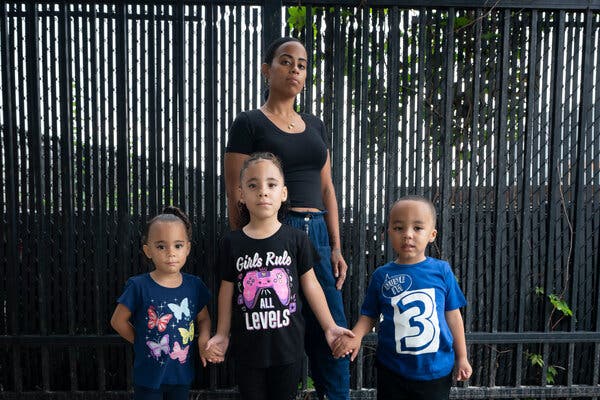Weather: Partly to mostly sunny. High in the upper 70s.
Alternate-side parking: In effect until Saturday (Rosh Hashana). Read about the amended regulations here.
Students who are homeless already face exceptional challenges in school. They are more likely to drop out, and they tend to perform worse than other students in several academic areas. Advocates have long said more services are necessary to address their learning needs.
As New York City’s 1.1 million schoolchildren plunge into a new experiment in remote learning, homeless students may not have the resources they need.
My colleague Eliza Shapiro wrote about how homeless families — who often rely on school for meals and health services — are feeling overlooked as schools move to reopen on Sept. 21 amid the pandemic.
[Remote learning has already taken a toll on the city’s homeless students and their families.]
The context
The number of city students who are homeless has grown by 70 percent over the last decade. One estimate released last year found that more than 114,000 students were homeless.
Roughly one-third of New York’s homeless student population lives in shelters, and many of the rest live doubled up with family or friends, a living situation that can be unstable.
And the city has struggled to accommodate them. Mayor Bill de Blasio’s administration has added some social workers who serve homeless children, but activists say more are needed.
Latest Updates: The Coronavirus Outbreak
The challenges of the pandemic
The hardships vary from family to family. The city has distributed free iPads, but some children are having difficulties logging on for remote classes. Some families are still unclear about whether they will have access to city-funded child care on days children are learning remotely.
Families cramped in small apartments do not have access to the social workers and staff in shelters that can troubleshoot issues with city officials.
Then there are connectivity issues: many shelter units do not have reliable access to Wi-Fi or cell service.
The experience of families
Crystal Berroa, above, a mother of three who lives in a shelter, said remote learning in the spring was a failure. But she has opted out of in-person instruction, despite not having access to reliable Wi-Fi, because one of her children has asthma. She said sending her children to school would be a “science experiment.”
The public Wi-Fi kiosks near the Manhattan shelter where Christlie Jean-Baptiste lives with her two children provide spotty service and rarely work during bad weather, making it difficult for her 9-year-old daughter to log on for remote learning. Ms. Jean-Baptiste said her daughter has also been despondent about not seeing friends.
Families in shelters, she said, are “kind of overlooked.”
From The Times
How New York City’s Police Unions Embraced Trump
2 Killed, 6 Injured in Shooting Near Rutgers University
50 Years Ago, They Did Something Rare in Gospel: Tied Music to Protest
It Was 50 Years Ago Today, the Marathon Came to New York to Stay
Want more news? Check out our full coverage.
The Mini Crossword: Here is today’s puzzle.
What we’re reading
City officials say that wealthy people who left Manhattan during the pandemic are not filling out the 2020 census, potentially costing the city billions in federal funding. [N.Y. Post]
New York has seen 37 straight days with a coronavirus infection rate of less than 1 percent, Gov. Andrew M. Cuomo said. [N.Y. Daily News]
Twelve firefighters were injured and several residents evacuated during an intense fire in Dyker Heights. [ABC 7]
And finally: Times readers help the neediest cases
The 108th campaign of the The New York Times Neediest Cases Fund, which ran from last October to January, raised more than $6.5 million for people facing hardship.
And when the pandemic hit, The Fund raised more than $1.8 million to help people get food and other aid during the outbreak.
“The generosity of Times readers to our annual campaign was incredible,” said Eileen Murphy, president of The Fund. “So we were extremely grateful, but not surprised, when they stepped up again to support our Covid-19 campaign.”
Now the 109th annual campaign has begun.
The Times’s Sara Aridi and Elisha Brown write:
The Fund’s 2020-21 campaign will feature weekly articles outside the paywall on how the agencies it supports are assisting those in need amid the pandemic. And it kicks off with a $1 million donation from the Ford Foundation.
“As a result of Covid-19, millions of New Yorkers are dealing with unprecedented economic insecurity,” said Darren Walker, the foundation’s president. “We in privileged positions must act to rise to the challenge of this historic crisis.”
This year, there are 10 beneficiaries:
The New York Times Company covers the administrative costs of the campaign, and the organizations spend the money at their discretion, often to cover holes in public assistance. Donations of $100,000 or more from trusts and estates go to The Fund’s endowment. Online contributions can be made through GoFundMe.
It’s Monday — lend a hand.
Metropolitan Diary: Sweet spot
Dear Diary:
Another summer evening was just falling, and I was enjoying dinner alone on my favorite boulder in St. Nicholas Park.
It’s a coveted boulder, flat and good for sitting, half-shaded by tall trees, with a sweeping view of the park below.
It’s rare to find it unoccupied, and sure enough, a group of preteen boys soon wandered onto it, lazily swinging baseball bats, chatting and spitting with all the practiced showmanship of boys their age.
I smiled a little, feeling passing regret at having my time alone disturbed.
The youngest among them looked no more than 10, and he was by far the smallest, but he spoke with the ringing authority of a leader.
“Yo, pull up, pull up,” he commanded. “Let her be by herself.”
And so they did.
— Camille Jetta
New York Today is published weekdays around 6 a.m. Sign up here to get it by email. You can also find it at nytoday.com.
We’re experimenting with the format of New York Today. What would you like to see more (or less) of? Post a comment or email us: [email protected].



















